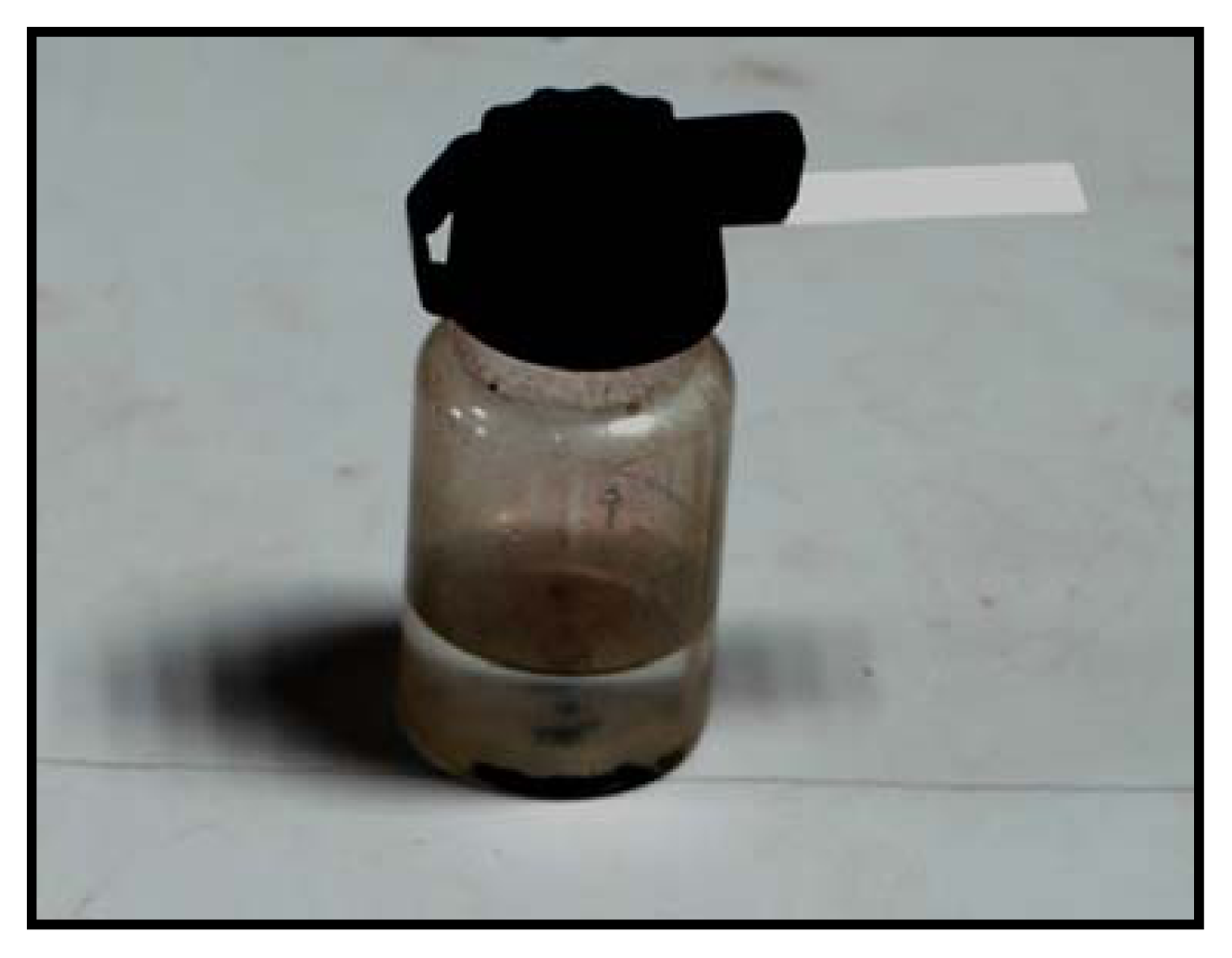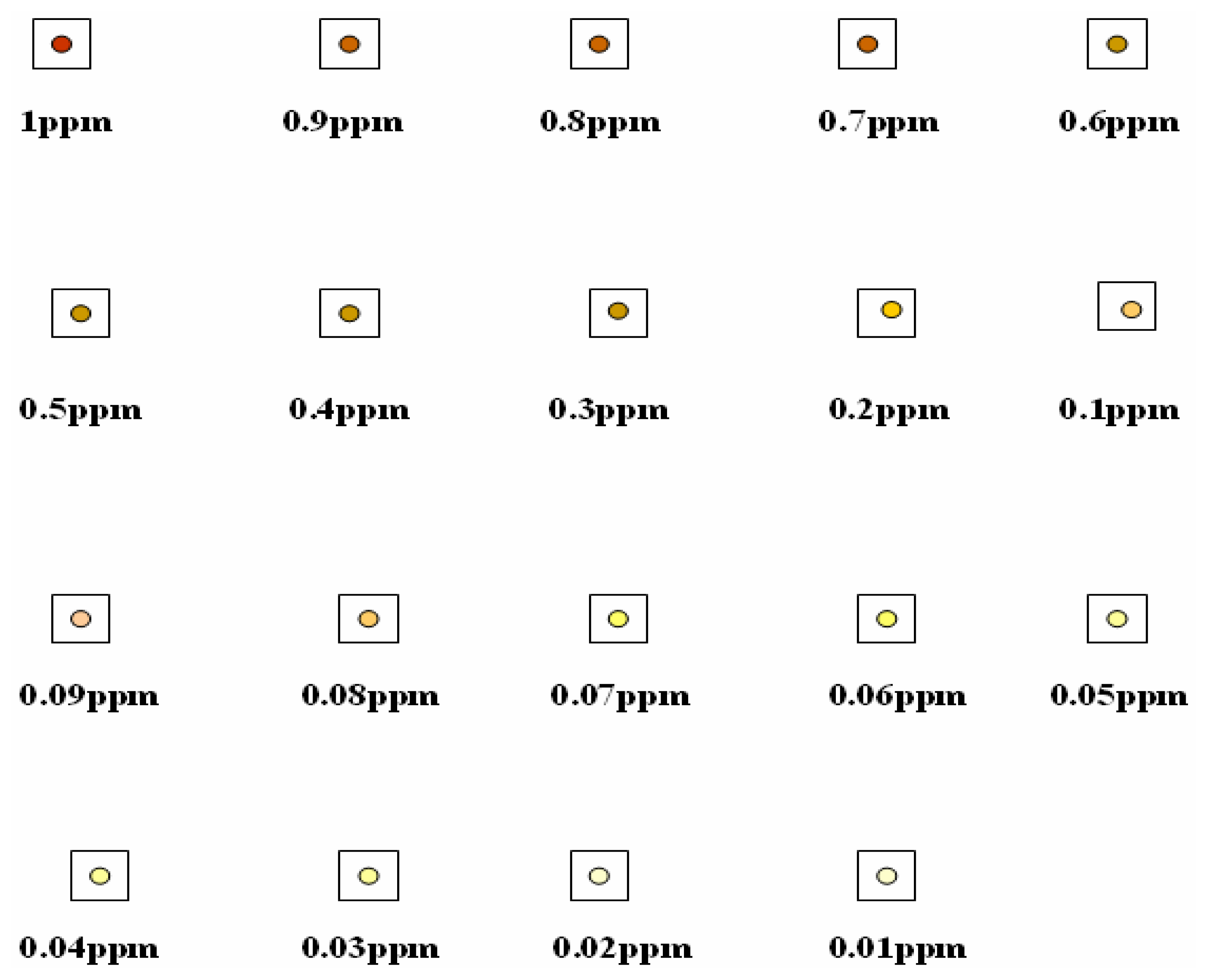Methods Based on the Mercuric-Bromide Stain
Field methods, based on the mercuric-bromide-stain [
3], consist of three different major parts, which are carried out stepwise.
The first part of the procedure is to remove serious interference caused by hydrogen sulphide. As most of the water samples from arsenic rich areas originate from reducing environments they are likely to contain various amounts of sulphur in its lowest oxidation state (hydrogen sulphide). This odoriferous compound reacts with mercuric-bromide to form a greyish-black precipitate, which makes the determination of arsenic ambiguous. Field kits that do not have a way to negate this interference are useless.
Two methods to remove hydrogen sulphide are currently in use; either the sulphide is oxidized to sulphate and the excess oxidizing reagent removed prior to the hydride generation step or, as is done in the larger number of available kits, the hydrogen sulphide is filtered out by passing the gas stream through a filter impregnated with lead acetate during the hydride generation step. The lead salts, which react with hydrogen sulphide, form insoluble lead sulphide, while the arsine gas passes the filter unchanged. Other interferences at this step of the analyses are normally not expected for drinking water analysis. When the kit is used for wastewater analysis then the larger concentrations of heavy metals (such as copper and nickel) may interfere with the hydride generating process and/or other hydride generating elements, e.g. antimony and selenium.
The second step, the generation of the arsine gas, is the most important one. The classical way is the use of zinc metal and hydrochloric acid, which produce the ‘nascent’ hydrogen, which is the actual reducing agent. The zinc metal has to be of a definite grain size (20–60 mesh) to ensure that the reaction progresses at a certain rate: not too fast – in order to ensure the maximum yield at the reagent paper, and not too slow – in order to allow the determination to be completed in a practicable time. At room temperature arsenate is reduced to arsenite, which is then reduced to arsine gas. The reduction of arsenate to arsenite is accomplished by adding a small amount of potassium iodide and stannous chloride and, depending on temperature, needs at least 15 minutes to be completed. Hydrochloric acid could be replaced by sulfamic acid, which is solid and avoids a major disadvantage of having to handle a corrosive liquid in the field. Sulfamic acid is a dry, non-volatile, non-hygroscopic, odorless, white crystalline, stable solid acid. It is moderately soluble in water by forming strongly acidic aqueous solution that is comparable in acidity to the common strong mineral acids but may be easily handled and stored in the dry form. Its solution is less corrosive towards metals than other mineral acids. It also removes any interference [
4] due to NO
2− as represented by the following equation:
Further sulfamic acid is non-flammable and non-explosive and requires no special safety measures during storage. To prevent from absorption of moisture and possible caking, it should be stored in a cool, dry place.
Evolution of Arsine
The following reactions will take place in the evolution of arsine:
Generally, two systems are in common use for the reaction of the arsine gas with the reagent paper impregnated with mercuric-bromide. The original version from 1907, still being sold, inserts a small reagent strip into a tube and the arsine gas passes over the surface of this paper. As the contact between the two reactants is not very intense, this method lacks sensitivity and has low reproducibility. Many tests, both in laboratories [
5] and in the field [
6], have shown that this method is not sufficiently reliable to test for low arsenic concentrations. If the flow of the arsine gas passes through, rather than over, the reagent paper then lower detection limits can be reached.
The third methodological step is the quantification of the arsenic concentration. The arsine gas produces a white to yellow to tan to brown spot on the reagent paper, which can be used for the quantification of the arsenic concentration, by visual comparison with a standard color chart (
Fig 2).
Sulphide Interference
The main interference caused in the estimation of arsenic by hydride technique is sulfur, which gets reduced under the potential where arsenic gets reduced to arsine.
During the reduction of arsenic to arsine gas, sulphides are also reduced to form hydrogen sulphide (H2S). Hydrogen sulphide reacts with the mercuric bromide test strip in the same way as the arsine gas, leading to erroneous results. Current methods for removing sulphide interference entail passing the arsine gas stream through a scrubber containing lead acetate to remove the hydrogen sulphide as lead sulphide. Even zinc and copper scrubbers are also used but they have been found to be less efficient. There are many drawbacks to these methods. Handling and disposal of hazardous lead acetate and lead sulphide is harmful, apart from this the rate of gas evolution has to be controlled to allow adequate contact time for the entire sulphide to react with the scrubber.
The new method eliminates the need to rely on these harmful chemicals to remove sulphide interference. Use of a desulphurizing agent for removal of sulphide interference and the desensitizing effect of the reagent is counter balanced [
7] by the use of ferric chloride [
8,
9] which increases the rate of evolution of arsine, so complete evolution of arsine takes place with in the reaction period and giving precise results.
Assessment of Optimum levels of cupric chloride and ferric chloride for removal of sulphide interference
In all these field kits hydrogen sulphide is usually the most serious interferent. This can occur as a dissolved gas in ground waters that are strongly reducing. A second source of hydrogen sulphide is the dissolved organic matter in the water, containing sulphur compounds, which may reduce to hydrogen sulphide during hydride generation step. So the amount of CuCl2 required to remove the interference of sulphide in the range 3–5ppm is systematically studied. The appearance of white color in the lead acetate strip indicates the removal of sulphide interferences, which indicates nearly 50ppm of CuCl2, is sufficient for removing sulphide interference. So in all the tests 50ppm of CuCl2 is recommended. Water samples containing different ppms of arsenic were analyzed by adding 50ppm of CuCl2 and this was found to be sufficient for arsenic concentrations in the range of 0.01ppm–1.0ppm. Further when CuCl2 is used to suppress the sulphide interference, it is observed that it also suppresses the release of AsH3 to certain extent. However it is observed that ferric salts (FeCl3) enhance the arsenic evolution and compensates the suppression effect of CuCl2 in arsine evolution. The amount of FeCl3 required to be added along with CuCl2 to attain maximum sensitivity for the detection of arsenic is systematically examined.
From all the tests run 50ppm of CuCl
2 and 100ppm of FeCl
3 are found to be effective in removing the sulphide interference and also in development of spots (
Fig. 3) in the estimation of arsenic in ground water. With this method, it was found that as much as 3ppm of S
2− could be tolerated before the acceptance criteria of 10ppb arsenic level. Clearly the presence of Copper (II) at normal levels cannot be tolerated in the determination of bismuth, selenium and tellurium as their hydrides, although the interference effect has been reported to diminish in the presence of iron.
For evaluating the merits and demerits of determination of arsenic by this method, tests were carried out and compared with other methods for the estimation of arsenic in drinking water samples, and the corresponding data are presented in the
Table 1. Here the concentration of the arsenic is taken in the range of 0.05–1.0ppm for reference only because the data related to other kits cited in the literature falls in this range. The results obtained by field kits were found to agree well with the data obtained through ICPAES method also (
Table 1B).







